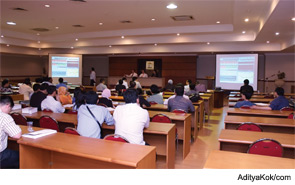e-Tips for Effective Presentations

- American College of Physicians: Scott C. Litin, MD, discusses how to improve presentation skills in a 60-minute session: playbackacp.com
- Yale Medical Library: Whether you need a guide to PowerPoint, slide templates, or medical images to include in your presentation, Yale’s online medical library can direct you to the source: med.yale.edu/library/education/powerpoint.html
Use PowerPoint, Sparingly
Rarely will a speaker give a presentation without using PowerPoint, but the program has become fatally easy, Dr. Hall says. “The problem is people try to cram too much info in too short a space of time, and you suffer from PowerPoint overload.” To prevent that from happening, he suggests having no more than one slide per minute of a presentation.
Dr. Miller has her own rule of thumb when it comes to PowerPoint: no more than six lines on a slide. “Presenters typically use busy, data-driven slides. Use simple graphs or emphasize the important statistics in a different color,” she suggests, noting that a well-chosen visual can significantly reduce the time needed to present a concept. “Visuals should be bold and brilliant, and they should be fully integrated into the presentation.”
Think on Your Feet
One key skill physicians traditionally haven’t been able to master is sensing the mood of the audience and altering their presentation accordingly, Dr. Hall says, adding that this is a huge aspect of keeping the audience engaged.
“Stand-up comedians sense how their presentation is going and alter it to the mood of the audience, and I think that is what really good medical presenters can do as well.” Although he says this capability isn’t something that can be taught, there are ways physicians can become more in tune with their audience. Dr. Collins suggests testing listeners using an audience response system prior to beginning a presentation. The remotes allow audience members to answer questions using the hand-held key pad so that presenters can query the audience to learn more about what they know and tailor the presentation accordingly. As Dr. Collins points out, the more prepared you are, the easier this will be.
“By rehearsing and being familiar with the content, you can alter a presentation so that if a question comes up about something you planned to talk about later, you can jump ahead to that information or tell the audience you plan to cover it,” he says.
Because no two presentations are the same, improving your speaking skills is something that you should build upon with each engagement, Dr. Hall says. “It’s a bit like show business. You’re only as good as your last presentation, because that’s the one that people remember.”



